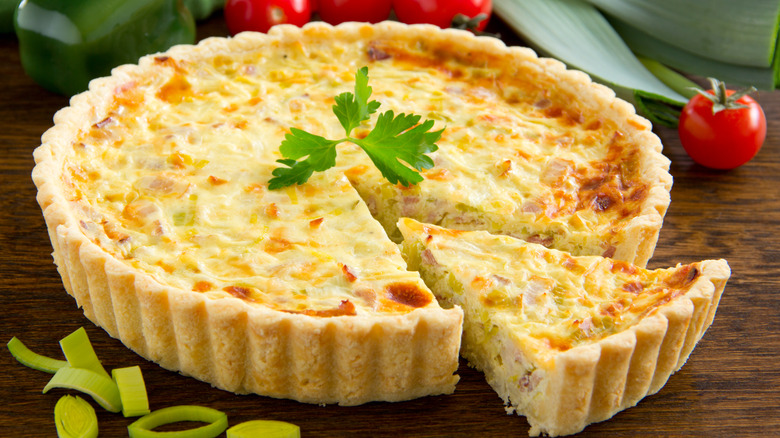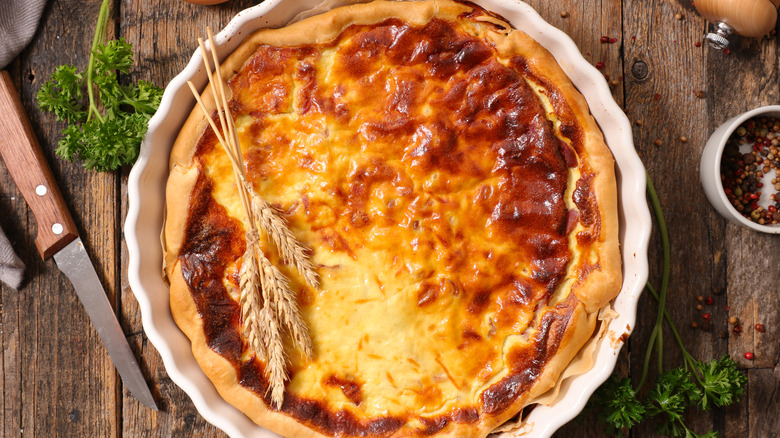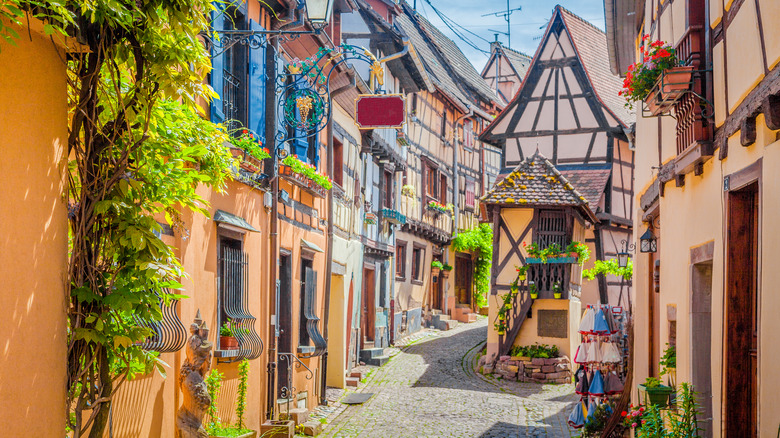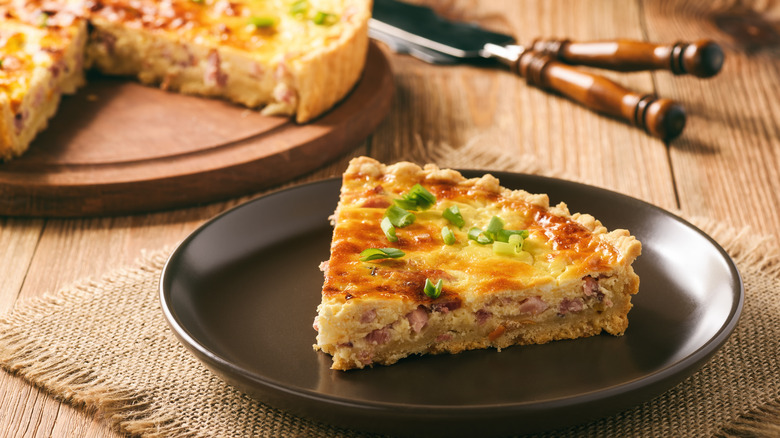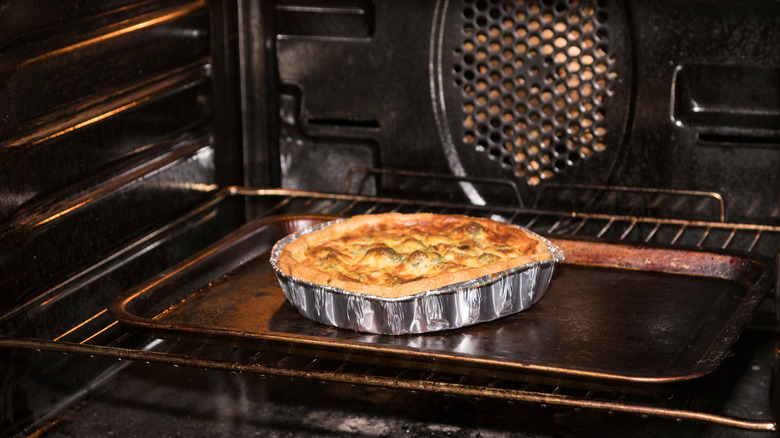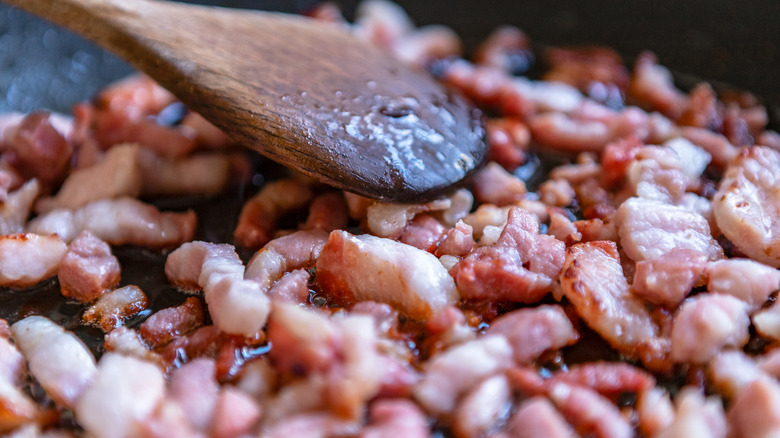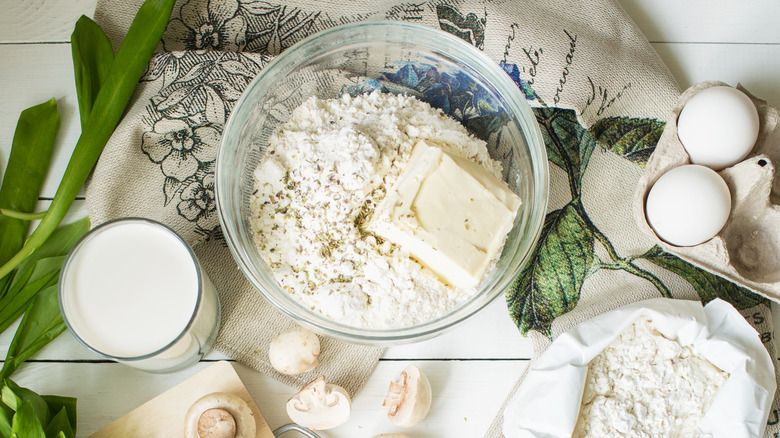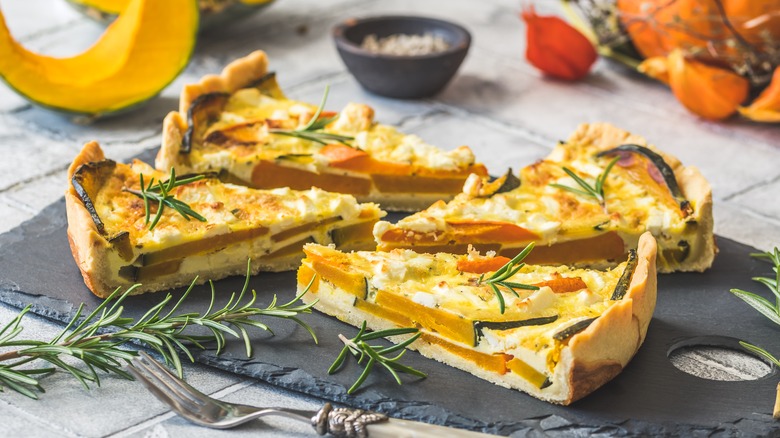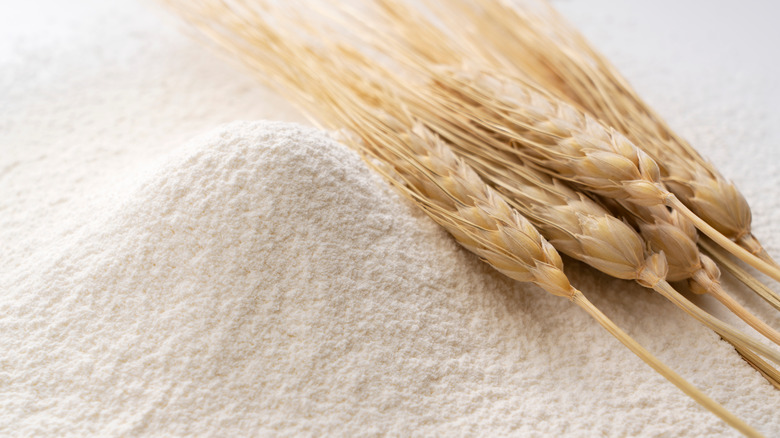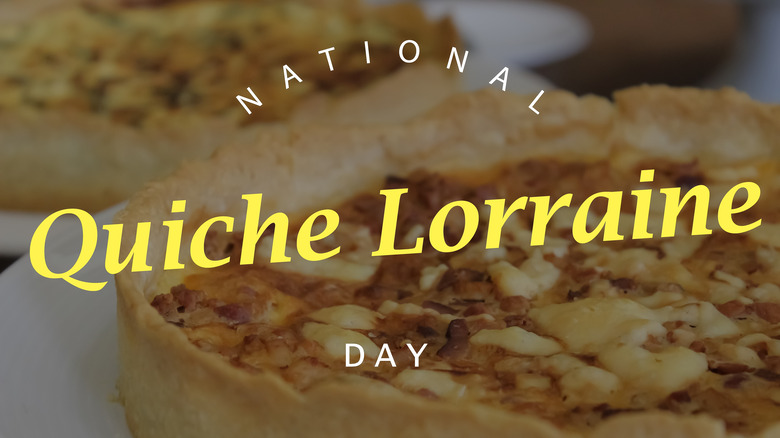What Exactly Is Quiche Lorraine?
Ah, the creamy taste of a savory tart with an unmatched silkiness is all you could hope for in an ideal bite of quiche Lorraine. Assuming you've got your hands on the perfect shortcrust pastry to accompany the symphony of ingredients that make up this classic French comfort food, you'll be able to enjoy the dish in both wintry and summery weather. Though many iterations of quiche have come since its origins in the 16th century, a traditional quiche Lorraine consists of cream, eggs, and bacon or ham, with more ingredients being included in the mix as the delicacy has evolved (courtesy of Regions of France). A meal typically enjoyed at room temperature or slightly warmed, quiche can be enjoyed for breakfast, lunch, or dinner, often with a side of potatoes or a crunchy side salad and simple vinaigrette to brighten things up.
Though ingredients used in quiches have been altered over time, the one and only quiche Lorraine — that's right, the original quiche — has largely remained untouched in its traditional preparation, with a few simple adjustments made early on. Quiche Lorraine is a simple recipe at its core, but there are a few things you may have not realized about your next meal, assuming you're now craving this delectable grub, of course.
Quiche Lorraine is not the same as regular quiche
Bits of broccoli, strips of cheddar, diced mushrooms, ground beef — all contenders for a hearty quiche, but not if your plan is to make a traditional quiche Lorraine. Quiche Lorraine is the go-to recipe for quiches and is much more minimalist than today's Americanized ones.
Though the differences can be subtle, quiche Lorraine includes fewer ingredients. According to Regions of France, the traditional style of this recipe will have cream, eggs, a sprinkle of nutmeg, salt and pepper, and French cubed bacon pieces known as lardons. Later on, cheeses like gruyère were introduced into the recipe, though no cheese first appeared in the first quiche ever, which hailed from a German recipe. Yes, you read that right — quiches are not quite French.
The addition of caramelized onions are known to have been included as the French adopted and developed the dish further, and this kind is also referred to as quiche Alsacienne, per Ocala StarBanner. A shortcrust pastry is traditionally the shell of quiche Lorraine, though puff pastry is widely used today. While it's perfectly okay to enjoy a slice of smoked salmon quiche, just know that you're officially indulging in something that is not traditional quiche Lorraine.
Quiche Lorraine is named after the Alsace-Lorraine region
A gorgeous, colorful region bearing the rare Mirabelle plum fruit and half-timbered houses, Alsace-Lorraine, now called Alsace–Moselle, geographically shares a border with Germany, Switzerland, and Belgium, though it is officially a part of France. Not always this way, a tug of war for the land happened back and forth between the French and Germans, each gaining control several times since 1681, according to The British Council. When Strasbourg, the regional capital of Alsace, was obtained by France, the country received dominance over it. Though France prohibited the use of the German language in 1945, it made its way back in the 1970s under pressure of independent movements. Alsatian is still a German dialect spoken in the region.
Strasbourg is the ninth largest city in the wine and cheese country, according to German Way, and is drenched in German and French culture alike. Given that it's a region boasting hefty, dense, and compact ingredients like cream, potatoes, cheeses, and many pork-based meats, especially smoked and salted ones, it comes to no surprise that quiche made its way into creation. Tarte flambée, a type of savory flatbread, is another popular regional delicacy reminiscent of ingredients similar to quiche Lorraine — dough, crème fresh, lardons, and sliced onions — and is served in regional restaurants and small bars as a snack.
Quiche Lorraine is considered French, but is of German origin
You'd be right to think that there's nothing more French than cream, eggs, and butter. Although prized as an Eastern French delicacy, quiche Lorraine was first known to exist in medieval Germany. The kingdom of Lothringen in Alsace was under German rule at the time, and was renamed Lorraine when the French took over.
As reported via Atelier Monnier, the French discovered the recipe and added more pizzazz to the original basic savory tart that was the German quiche — eggs and cream blended into a simple thick custard encrusted by a tall bread dough. A meal fit for a king, more spices were added when French hands got ahold of it.
One adjustment was with the base, going from the original dough to a new, cleverly designed shortcrust pastry that would add a crunchy yet soft texture to the dish under revision. This is why quiches are typically now made using shortcrust pastry. Following suit, England caught on to the quiche craze after WWII, after troops were sent back home with a newly found recipe now holding a reputation as French. The now-hip food trend wouldn't end there, finding a place in kitchens in the United States beginning in the 1950s.
Quiche Lorraine has been around for centuries
The 1500s might have been a long while ago, and we can be grateful that quiche Lorraine has stood the tests of time, despite being subjected to ingredients like Brussels sprouts and tomatoes today. But hey, who are we to judge?
While Alsace-Lorraine was still under German rule, the Lothringen kingdom lasted from the 4th century up until the 1600s in the medieval period, per Ocala StarBanner. The word "quiche" comes from this time in history, rooted from the German word for cake, "kruchen," according to The Courier. Resembling the likes of a decadent, open-faced omelet pie rather than a cake you'd see today, this original dish was cooked in a cast iron pan. This early version of what became the French classic was less caloric than kinds today, and cheese and meat were still omitted from the recipe. Though that's nothing a little German-French culture collaboration wouldn't eventually solve.
It was not uncommon in other parts of Europe to use easy-to-come-by ingredients like milk or cream with eggs and pastry doughs. Italians used them often during the 13th century, as did the English in the 1500s. So the perfect, long-lasting marriage of ingredients making up the quiche Lorraine was only meant to be.
The cheese typically used in Quiche Lorraine (if any) is gruyère
It's difficult to imagine a cheese-less quiche in today's world. Not only does cheese add an undeniable yum factor to the dish, it also serves the tart with a pleasant texture. Although cheese was included later on in quiche Lorraine recipes, remember that the popular French ingredient was absent from the first of these quiches.
So which lucky block of dairy was introduced into quiche Lorraine? Gruyère is commonly used, a type of hard cheese dating back to the 12th century. With origins in Western Switzerland in a town bearing the cheese's very name, it's made from cow's milk and lies unpasteurized, according to Nutrition Advance. Gruyère, thanks to its nutty and salty flavor profile and natural texture, is great for enduring heat while baking. Known as one of the most popular kinds of cheese on the globe, gruyère ages for five to 24 months.
An array of cheeses are now used in modern quiches, especially goat's cheese and different kinds of cheddar and gouda. However, if you're looking for an authentic quiche Lorraine, just know you'll want to keep an eye out for one with gruyère.
Lardons are key for an authentic quiche Lorraine
The omission of meat from quiche Lorraine did not last long after the French enhanced the German quiche with their je ne sais quoi. Though bacon has become a regular ingredient used in quiches today, quiche Lorraine has a similar ingredient. This ingredient is known in France as lardons. Think "French bacon," as they're made from the same slab of meat but cut differently, according to The Baconer.
Sliced into half-inch thick and one-inch long pieces resembling small sticks, bacon lardons allows for a bit more intense flavor profile than bacon that's been cut into strips, making it the original perfect fit for a quiche. With the fat rendering on the skillet before it's placed into the creamy tart, it's clear why it's an original French ingredient in quiche Lorraine.
With its ability to crisp up yet remain softer on the inside thanks to its width, lardons have a caramelized outer shell, lending to a slightly sweet yet savory flavor. The main difference between lardon and pancetta is in the way it's smoked instead of dried.
Quiche Lorraine is more about the cream and less about the eggs
Dishes like frittatas and omelets have been brought into the conversation as distant cousins of the quiche. It's worth noting, however, that they're quite different because they, unlike quiche, can be made without the use of cream (if you were ever curious about that). For a standard, impeccable quiche Lorraine to live up to the hype, the cream should be the lead vocalist with the eggs providing backup.
According to Regions of France, there must be more cream than egg in quiche Lorraine for the purpose of creating a smooth, even consistency across the tart. The eggs and cream are essential together to provide texture, but with more egg than cream, a quiche can quickly turn into a different dish also enjoyed by the French — the omelet (and an overly creamy one at that).
Why not take it from the French chef Jacques Pépin, who uses only three eggs for his traditional quiche Lorraine, and that's with a total of one and a half to two cups of cream, according to a YouTube video in which he prepares the dish. Call it the traditional way, but it'll also make for a better-textured quiche experience.
It became a popular brunch dish in the U.S. during the 1970s
Quiche finagled its way to popularity in America in the 1970s, the decade of bell bottoms and "Star Wars." It became the perfect meal for any time of the day, especially when paired with a healthy bed of greens. The dish particularly gained popularity in the brunch world across cafés and restaurants, according to the LA Times.
Quiche in the 1970s and the 1980s was all about sustenance. If you could think it, it probably had a place in your now overbearingly filled quiche. The Rambling Epicure tells us that quiche became a relative to pies and casseroles, despite having a slightly thinner crust to hold everything together. Notably, a fourth of an entire quiche was considered one single serving.
The savory tart evolved into an everything-but-the-kitchen-sink situation when home cooks used leftovers lying around in their fridges. Mushrooms, broccoli, sun-dried tomatoes, and even smoked salmon, along with different cheeses, were included in recipes, straying far from the original intent of the quiche.
Quiche was humorously deemed effeminate in a satirical book
You may have heard of a saying that goes like this: "Real men don't eat quiche." Now you might be thinking, "What did quiche ever do besides be ... perfect?" Given the nonsensical thinking of such a sentiment, you might have picked up on why the saying originates from a satirical piece. In 1982, a humorous nonfiction book entitled "Real Men Don't Eat Quiche" was published, followed by the subtitle, "A guidebook to all that is truly masculine" (via Goodreads).
Written by an American screenwriter and satirist, Bruce Feirstein, the book, a play on classic stereotypes regarding how men "should" act in order to be "macho," lasted on bestseller lists for over a year. One standard Feirstein toyed with was the eating of meat. As quiche during the 1980s was mainly vegetarian, particularly due to the dish's surge in popularity just the decade before, it received a reputation as "feminine" due to its lack of meat, per Importico's Bakery Cafe. "Quiche-eaters" were deemed "sensitive new age guys" in Feirstein's book, and though most knew it was satirical, quiche sales did decline among men during the time, according to Culinary Lore.
The largest quiche in the world had 140 pounds of flour
One may reasonably cap their quiche intake at a couple of slices, but how does an entire quiche large enough to feed 125 people sound? Let's remember that a quarter of a quiche did make up one serving in the 1970s, though that's no excuse to want a 125-slice monster.
AP News reported that the heftiest quiche ever made was baked in a 16-foot-wide pan for a total of 18 long hours. Once taken away from the heat, the massive creation was the size of a queen-size bed. According to Newport Ave Market, this quiche carried 140 pounds of flour. Made in Paris in 1997, Chef Alain Marcotullio used 1,928 eggs, 156 pounds of bacon, 134 pounds of butter, and 125 quarts of milk. Thirty cooks helped him in this wild endeavor, according to The New York Times.
A man dressed as a forest warden from the 18th century was enlisted to beat a drum in celebration. Marcotullio asked the Guinness Book of World Records for recognition of his giant savory French cream tart, though the book did not have a category for quiches at the time.
There's a national quiche Lorraine day
You've heard of National Donut Day, but why limit celebrations to just dessert? If you're looking to impress your peers at least one day out of the year, it might just be your time to shine every May 20. That's when National Quiche Lorraine Day is celebrated, and you should totally try your hand at making one (via National Today).
The national food holiday doesn't have much to it, other than leaning into your love for quiche Lorraine. Preparing your favorite quiche recipe can be one way to go. You can also enjoy white wines that pair well with the dish, many of them in fact hailing from the Alsace-Lorraine region, such as Pinot Gris and Riesling, according to Forbes. Though if you're hardcore craving this delicious savory dream of a tart right now, remember — you don't have to wait until May.
